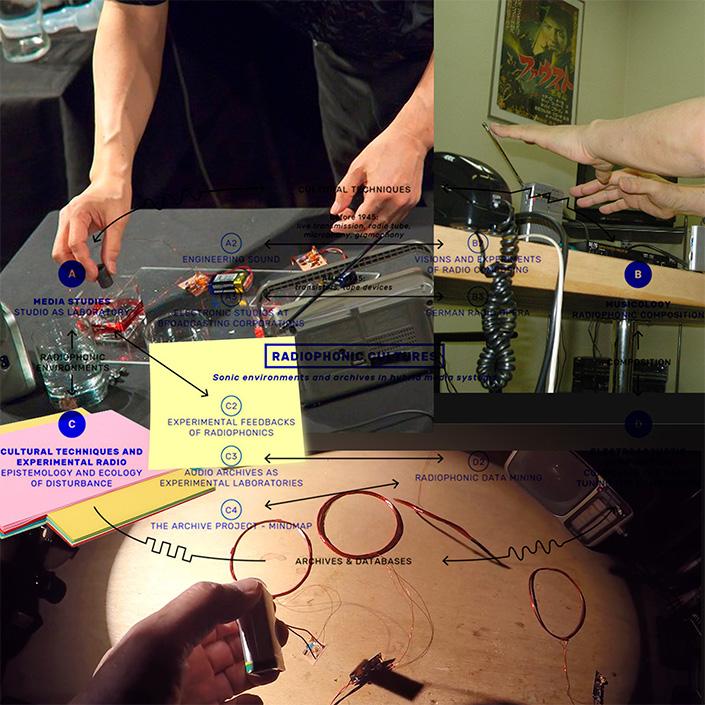Is There Really a Place on Radio for Experimentation?
"Inductance" by Tetsuo Kogawa on Electronic Waves (C2 Experimental Feedbacks on Radiophonic)
“ The first few minutes of his performance were silent as he wrapped two water glasses with red ribbon and went on to construct a primitive radio transmitter. He produced some wild and unpredictable results by adjusting the parameters of an unstable feedback loop running between his transmitter and two household radios by moving the transmitter”
Phil England, The Wire, January 2011
After studying philosophy at Sophia (Tokyo) and Waseda University, Tetsuo Kogawa spent many years in New York City. He taught at Wako University (1972-1989), Musashino Art University's Department of Video and Cinema (1989-1994) and Tokyo Keizai University's Department of Communication Studies (1994-2012). Kogawa introduced the free radio movement to Japan, and is widely known for his blend of criticism, performance and activism. He has written over 30 books and numerous articles on radio art, media culture, film, city and urban space, and micro politics. He has shown his artistic and useful workshops to build Mini FM and micro radio transmitters in many cities of Canada, US and Europe. Most recently he has combined the experimental and pirate aesthetics of the mini FM and micro radio technology with internet streaming media in such projects as Radio Party, Translocal Palimpsest, and Radio Kinesonus.
He was invited by The Banff Center of the Arts, Western Front, Next Five Minutes, Bauhaus University, Kunstradio, Tate Modern, Walker Art Center, Govett-Brewster Art Gallery, Deep Wireless, Musicprotokol, AV Festival, Instal, Cut & Splice, FON and so on.
-
Radio, as a heterogeneous mix of technological progress and aestheticised desire, goes far beyond being merely a medium of communication. This series of podcasts aims to highlight this fact, offering a selection within the wide variety of topics currently being explored, most notably the confluences and limits and the possibilities of dissemination and the presence of silenced histories.
Depending on the chosen historical and theoretical paradigm, multiple and even contradictory histories of radiophony can be constructed. Therefore, research starts from a general corpus of concepts which explore, along with a fascination with the medium, a utopian and unconventional treatment: the "Radio-Eye" and the Radio-Pravda manifesto of Dziga Vertov; the public interaction and communication of Bertolt Brecht; William Burroughs' cut-ups and communicative disruption; Velimir Khlebnikov's "The Radio of the Future"; and the concept "Radio Mind" by psychologist Upton Sinclair. As media theorist Allen S. Weiss states: “Radio is not a singular entity but rather a multitude of radios” and "radiophonia is a heterogeneous field encompassing diverse apparatus, practices, forms, and utopias”.
Opposite the canonisation of the field and radiophonic methods, there are people and collectives that opt to keep margins fluid and encourage participation, reflection and interaction through experimental approaches and applications. To invent and reinvent radio is to approach radiophonic space as a creative space. Thus, the series seeks to establish an open and fragmented dialogue with media artists, creators and thinkers on the relationship between radio, society, technology and experimentation through singular and idiosyncratic radio pieces.

Agnès Pe, collage made from images of projects by Tetsuo Kogawa, 2023
Share
- Date:
- 22/11/2023
- Production:
- Agnès Pe
- License:
- Creative Commons by-nc-nd 4.0
Audio quotes
Inductance by Tetsuo Kogawa on Electronic Waves (C2 Experimental Feedbacks on Radiophonic)
- Tetsuo Kogawa. “Inductance 03”, performance for DeepWireless Festival, Canada (2012). Available online
- Herbert Marshall Mcluhan. Lecture at ABC Radio National, Australia (1979)
- Tetsuo Kogawa. "Natural Radia", live session with Hank Bull on the telephone from Vancouver from ORF Funkhouse Studio RP4, Austria (2002)
- Doris Day. "Whatever Will Be, Will Be (Que Sera, Sera)" in Whatever Will Be, Will Be (Que Sera, Sera). Philips (1956)
- Tetsuo Kogawa."Art’s Birthday Special" in Radio Kinesonus. Jacques Foschia, Hiroshi Hasegawa, Kenji Maehara and Tetsuo Kogawa improvised together using telephone, internet, transmitters and various electronic devices (2004)